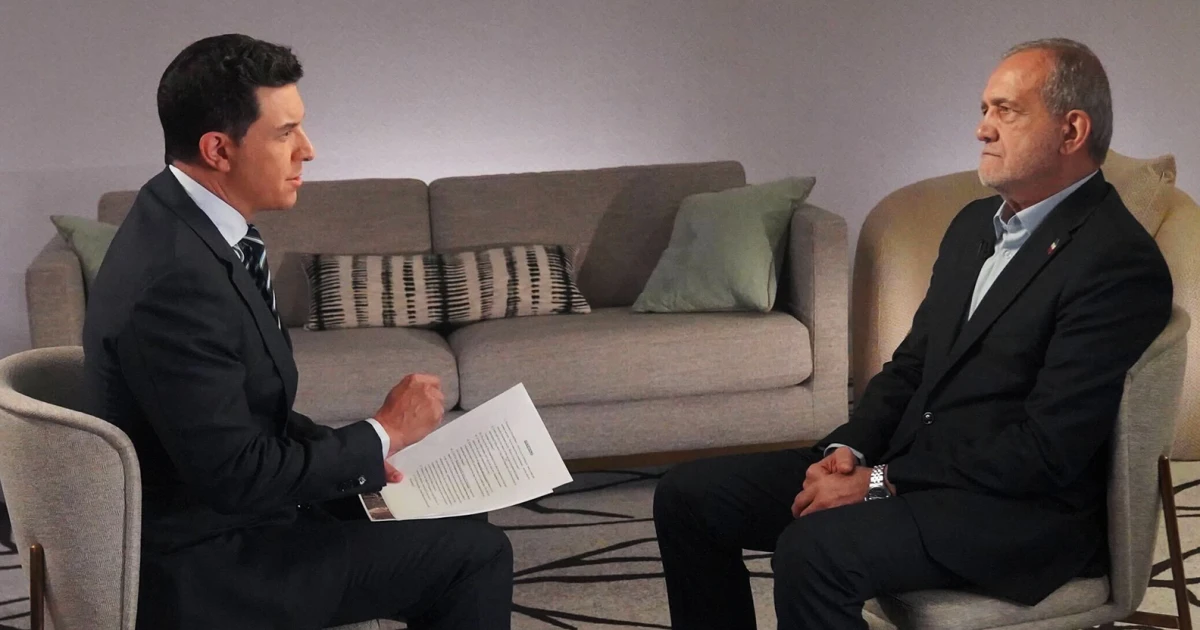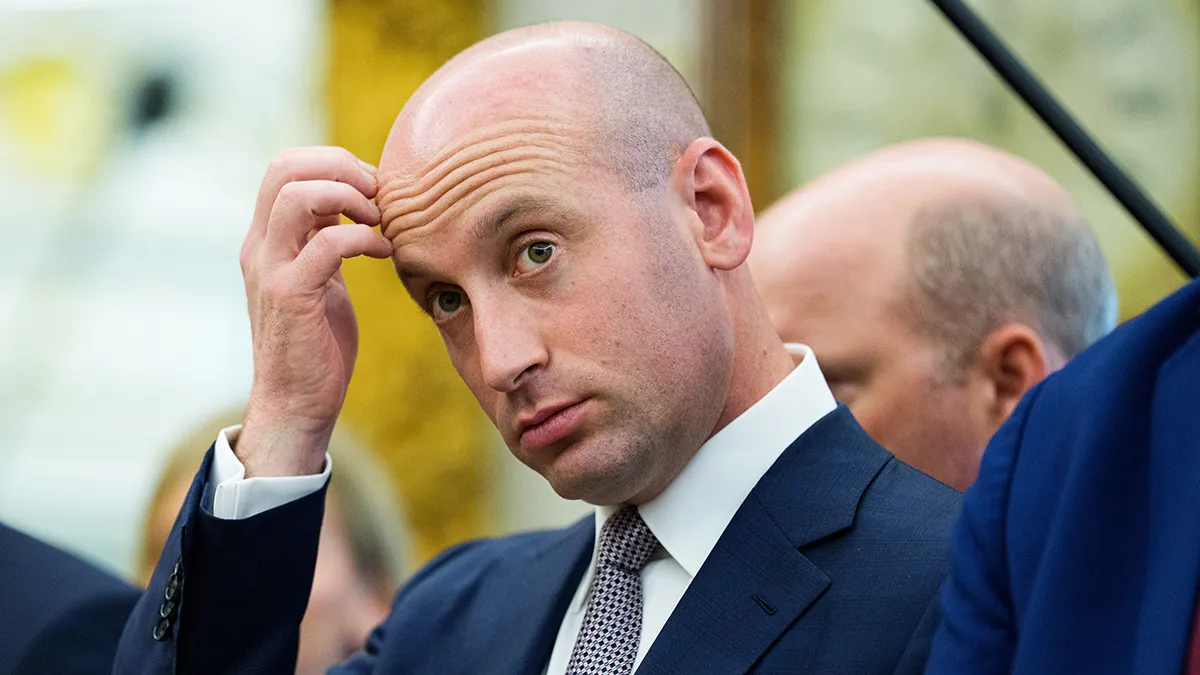
Iranian President Masoud Pezeshkian has spoken out against forcing women to wear the hijab and recent crackdowns in his country, pitting him against hardline rivals in the Islamic Republic.
“Human beings have a right to choose,” Pezeshkian said Friday in an interview with Tom Llamas, anchor of “NBC Nightly News,” when asked about Mahsa Amini, whose death three years ago after being detained by Iran’s morality police triggered nationwide protests that shook the government’s hold on power.
“We didn’t have appropriate management of our internal issues and implementation,” he added during the extensive interview, during which he warned President Donald Trump’s actions could “set fire” to the region and said international nuclear inspectors were welcome to visit his country.
“I took very crystal clear positions in speeches that I gave in certain places in mosques, I clearly said this should not have occurred,” Pezeshkian said.
While this is not the first time Pezeshkian, who is considered a moderate and has criticized officials and security forces, has spoken out about the implementation of Iran’s hijab laws and subsequent crackdowns, he also said the rest of the world was “blowing things out of proportion.”
“Of course, each human life is priceless,” he said. But, “on a daily basis, hundreds of people are being killed in Lebanon, in Gaza, in all over Palestine, in Yemen and Syria, yet no one bats an eye? Why? These are less human beings?”
Despite Pezeshkian’s moderate position on the issue of hijab, observers say he has little power to stop security forces who have used the war with Israel last June as a pretext to carry out mass arrests of ethnic and religious minorities as well as Afghan migrants, according to human rights groups.
The interview was conducted with a government interpreter present and translating in real time, and NBC News reviewed the translation independently.
Nuclear program
Iran has renewed construction work at an underground site dug into the side of a mountain since the United States and Israel bombed the country’s nuclear facilities, in a sign that Tehran is likely trying to rebuild its heavily damaged nuclear program, according to commercial satellite imagery and experts.
In the three months since U.S. and Israeli warplanes struck three main nuclear facilities in Iran, satellite photos from Maxar indicate significant construction activity at Kuh-e Kolang Gaz La, or Pickaxe Mountain, which was not targeted in the air war. The site is near Natanz, a key nuclear facility that the U.S. military hammered with massive “bunker buster” bombs in June.
The images show the construction of an elaborate security fence encircling the mountain, a concrete frame built around a tunnel entrance and a growing pile of excavated soil — suggesting continued tunnelling, analysts said.
The Washington Post first reported on the satellite imagery.
“It’s clear that Iran is trying to rapidly construct a very deep underground facility just about a mile south of their uranium enrichment facility,” said Joseph Rodgers, a fellow at the Center of Strategic and International Studies think tank.
“The construction has really doubled down at Pickaxe Mountain, and they’ve definitely continued to drill,” said Rodgers, who recently produced a report about work at the site.
The White House and CIA did not immediately respond to a request for comment.
Llamas asked about the Washington Post report and whether the regime was building another nuclear facility. Pezeshkian said nuclear inspectors were welcome to visit his country.
“If they are really telling the truth we have been … we have come to an agreement, most recently, with the IAEA, they can come and inspect on the ground,” Pezeshkian said, referring to the International Atomic Energy Agency, a watchdog body.
“To put something out based on purported satellite photography it’s not pertinent in order to create frameworks that are not based in reality. In fact, would it not be easier and much more tangible and verifiable to have inspections in person on the ground?” he added.
The purpose of the site remains unknown. The latest satellite photos suggest Iran may be cautiously developing the location as an option for uranium enrichment or other nuclear work beyond the reach of America’s powerful “bunker-buster” munitions, analysts said.
“If they were planning on giving up their nuclear program, I don’t think we would see this construction,” said Jeffrey Lewis of the Center for Nonproliferation Studies. “They are going underground. Maybe they’re coming to the table, but they are definitely going underground.”
Supreme Leader Ayatollah Ali Khamenei, the highest authority in Iran, limited the scope of what Pezeshkian could accomplish during his time in New York when he said in an address on Tuesday that Iran would not talk directly to the U.S. about its nuclear program and would not negotiate on the issue of ballistic missiles or uranium enrichment.
While Iran maintains that its nuclear program is peaceful, hardline parliamentarians have called for the building of a nuclear weapon. The country now enriches uranium to near-weapons-grade levels — the only country in the world without a nuclear weapons program known to do so.
Asked about the high level of enrichment, Pezeshkian said, “The religious leader of the country issued fatwa and repeated … multiple times that it is unholy, or haram, to seek weaponization, to seek nuclear weapons, to seek any type of weapons of mass destruction. This is rooted in our ideology. It is unambiguous. And it is not changeable. So nothing has prevented us from having … the fullest cooperation with the IAEA.”
On Friday, the United Nations Security Council voted against a Russian and Chinese resolution to delay reimposing sanctions, which, despite the diplomatic push from Pezeshkian and his foreign minister, Abbas Araghchi, will very likely lead to penalties being reimposed after the Saturday deadline.
Without a diplomatic breakthrough on the sanctions, critics will likely blast Pezeshkian for coming home empty-handed.
“Pezeshkian’s presidential campaign was premised on diplomatic engagement abroad and attempts to moderate the regime’s heavy hand at home,” said Ali Vaez, Iran project director at the International Crisis Group. “More than a year into office, the limits of significant shifts within a system trapped in half-measures are clear.”
‘Set fire’ to the region
Before traveling to the U.S., Pezeshkian was urged by prominent intellectuals and former officials to meet with Trump directly to reduce tension and prevent another attack from the U.S. or Israel. Asked if he was concerned about more war coming to Iran and an expected meeting between Trump and Israeli Prime Minister Benjamin Netanyahu, Pezeshkian struck a defiant tone.
“We’re not afraid of war. We do not seek war,” he said. “President Trump has said that his administration has come to create peace, but the path that they have embarked upon will set fire to the entire region.”
He went on to say that while Iran has “never started a war. We will never be starting any wars.”
“But whomever attacks us, we will do our utmost to give them the strongest answer. We will certainly augment our capabilities on a daily basis so as to prevent anyone from attacking us,” Pezeshkian added.
The interview was conducted with a government interpreter present and translating in real time, and NBC News reviewed the translation independently.
Injury during an airstrike
Pezeshkian, who practiced as a doctor before entering politics, addressed an injury he sustained during the 12-day war with Israel in June, during which senior military leaders, scientists and hundreds of Iranian civilians were killed. Twenty-eight Israelis died during the conflict.
“They hit us because they were seeking to martyr us like everyone else. We are not afraid of death and martyrdom. We have lived our lives. I have lived my life,” he said.
As for his wounded leg, Pezeshkian said, “it wasn’t anything special.”
“We can just say that it was a hematoma formed in the region of the knee. We dropped the needed liquid and blood, and after that, we got over it,” he added.



